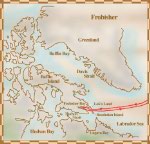 |
|||||||||||
|
|
Martin Frobisher: The Pirate-ExplorerFirst Voyage
|
||||||||||
 |
||
| Frobisher discovered the bay now known as Frobisher Bay, off of Baffin Island. Frobisher thought that the bay was a strait between Canada and Asia Copyright/Source |
||
Frobisher wanted to find the Northwest Passage over North America to Asia. Many people were trying to find a faster way to Asia at this time, so the person who succeeded would be rewarded by the Queen and become rich and famous. He finally got permission. Frobisher left with three ships. His own ship the Gabriel was only 20 tons and had a crew of 18. The Michael was 25 tons, and shortly after leaving England's shores, its crew deserted. A third ship, only 7 tons, sank in a storm off Scotland. The Gabriel sailed onů
 |
||
| An Inuk hunting from his kayak Copyright/Source |
||
Continuing in the Gabriel, Frobisher found a bay, which he thought was a strait between Canada and Asia. He named it Frobisher Strait; it is now known as Frobisher Bay. He couldn't sail to the end of the bay because five of his men disappeared after rowing to an Inuit village. He captured an Inuk man to try to ransom his men back, but he never saw them again.
When he returned to England, though, he brought back a stone he had found on his travels. It sparkled like gold.
Swan Song
The Inuk that Frobisher kidnapped was brought back to England. There, he delighted his audience with his skills with a bow and arrow. He shot Queen Elizabeth's swans on her lawn at Hampton Court. He died soon after, probably of a European disease. Not because he'd angered the Queen!
 
|